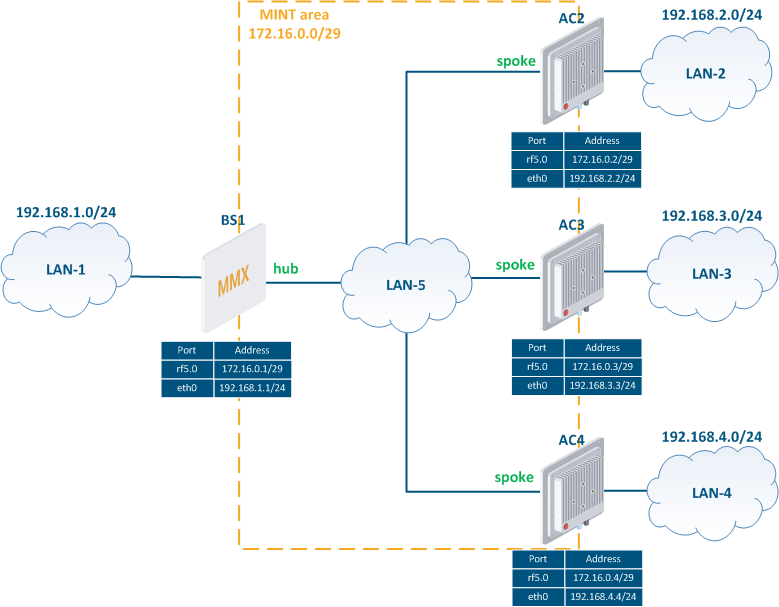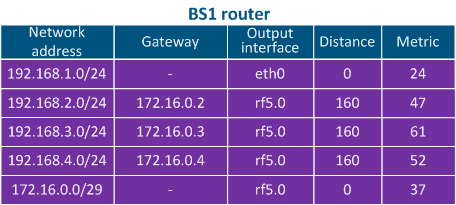Table of
...
contents
| Table of Contents | ||
|---|---|---|
|
...
ODR (On Demand Routing) - the protocol for a routing information propagation used in a star network topology. The point-to-multipoint topology is a star topology, so ODR is widely used in wireless networks. The ODR algorithm, unlike the other dynamic routing protocols, is very simple, so its operation is not resource-intensive.
Let's look at the ODR's protocol operation based on the example in (Figure 1). The network scheme consists of a base station BS1 and three subscriber devices CPE2, CPE3 and CPE4, connected to BS1. There is a A local network segment with its own IP addressing after is present behind each wireless device. An IP subnet is also assigned to the MINT area.
- Step 1: pre-configuration. It is necessary to establish a radio link between the wireless devices, assign IP addresses to network interfaces , and to globally disable switching. The devices routing table after preconfiguration of the devices after the pre-configuration is shown in Table 1.
- Step 2: roles role distribution. The ODR protocol operates with devices of two roles typesuses two role types that must be configured on each device according to the case: hub - central device, spoke - end devices. Usually, the base station sector, which has a connection to the backhaul network, acts as the central device , and the subscriber stations with having the user devices connected, act as end devices.
- Step 3: default route sending. Devices with The devices having the hub role configured send messages to inform all the devices about their role. To send such messages, the service fields of the MINT protocol are used (see InfiLINK 2x2 and InfiMAN 2x2: Switching), so all message the recipients are situated in the MINT area. Receiving When receiving such a message, the devices with having the spoke role form create a hub list of hubs. Since in a star topology a device with a hub role has a connection to the backhaul, a the device with a spoke role can add a default route to the its routing table by specifying the hub's address as the gateway (Table 2). One MINT area can have several devices with having the hub role, therefore each spoke can have several default routes in the RIB.
- Step 4: default route selection. The MINT protocol is used to distribute information about the devices with having the hub role, which has . MINT uses an internal metric that indicates reflects the radio parameters of the links and their current load, so the criteria for choosing a default route and adding it to FIB is the smallest metric value. The metrics metric analysis is performed permanently for each device with having the hub role, therefore, if the metric for of the used route grows, it can be replaced by another one with a lower metric. Thus, the fault tolerance and load balancing functions are implemented.
- Step 5: routing information distribution. Each device with the spoke role generates service messages for each device with the hub role. These messages contain information about the directly connected and about the static routes in the device's FIB. Note that information about the networks common with the hub is not included in such messages. For example, CPE3 will report network 192.168.3.0/24 to BS1, but will not report network 172.16.0.0/29, because the BS1's radio interface is associated with this network and the BS1's FIB already has information about it (Table 1).
- Step 6: connectivity between all LAN segments is established. The necessary routes have been added to the routing tables of the wireless devices (Table 2).
| Center | ||||||||||||||||||||||||||||||||||||||||||||
|---|---|---|---|---|---|---|---|---|---|---|---|---|---|---|---|---|---|---|---|---|---|---|---|---|---|---|---|---|---|---|---|---|---|---|---|---|---|---|---|---|---|---|---|---|
Figure 1 - The ODR protocol's operation scheme in a star topology network
Table 1 - Wireless devices routing tables Routing tables of the wireless devices after pre-configuration
Table 2 - Wireless devices routing tables after Routing tables of the wireless devices after the ODR configuration |
Usually ODR protocol is used in PTMP schemes (Figure 1), however, for a better understanding, let's complicate the scheme by implementing the balancing and fault tolerance function (Figure 2):
...








